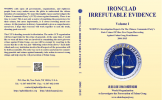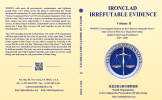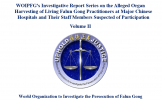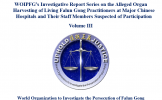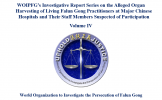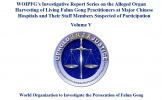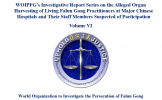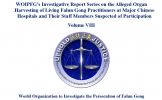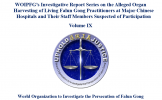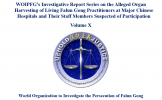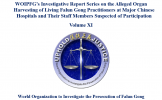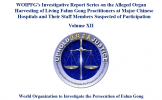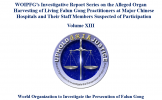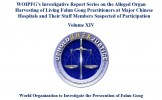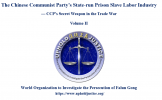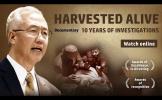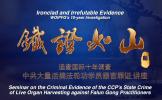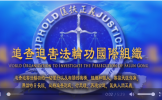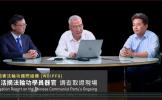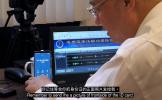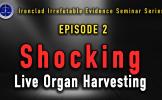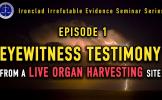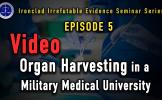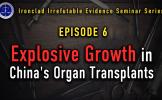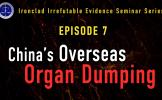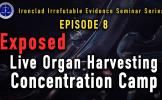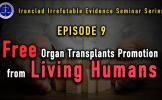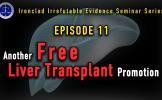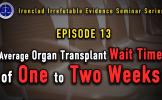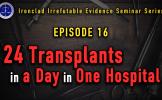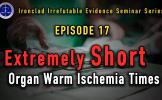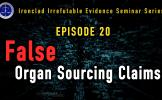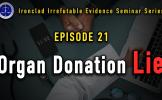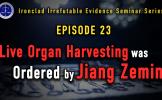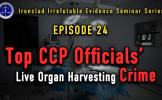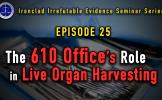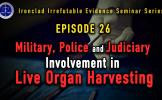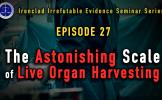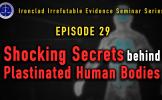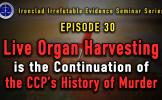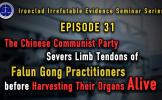ORGAN HARVESTING: An Examination of A Brutal Practice
COMMITTEE ON FOREIGN AFFAIRS HEARING
Subcommittee on Africa, Global Health, Global Human Rights,
and International Organizations
Christopher Smith (R-NJ), Chairman
&
Subcommittee on Europe, Eurasia, and Emerging Threats
Dana Rohrabacher (R-CA), Chairman
2:00 PM Thursday June 23, 2016
Room 2200, Rayburn House Office Building
———————————————————————————————————---
Medical Papers and Official Publications from China
Show Mass Murder for Organ Transplants
Charles Lee, M.D., Director of Public Awareness,
World Organization to Investigate the Persecution of Falun Gong (WOIPFG)
Thank you, Chairman Chris Smith and Chairman Dana Rohrabacher, committee members and staff, for giving me the chance to testify here. I would also like to thank Mr. David Matas, Mr. David Kilgour, and Mr. Ethan Gutmann for standing together with us to expose these heinous crimes that have never taken place before in human history.
1. WOIPFG and Its Investigations into Organ Harvesting
WOIPFG was established on January 20, 2003, with the mission to investigate the criminal actions of all institutions, organizations, and individuals involved in the persecution of Falun Gong; to bring such investigations, no matter how long they take, no matter how far and deep we have to search, to full closure; to protect the fundamental principles of humanity; and to restore and uphold justice in society. As of May 10, 2016, we have published 331 investigative reports on the persecution of Falun Gong, totaling 5.8 million words. We have compiled a list of 76,132 individual perpetrators, and 35,551 responsible institutions.
The explosion of the organ transplant industry in China since the persecution on Falun Gong began has resulted in many investigations into forced organ harvesting from prisoners of conscience, especially from practitioners of Falun Gong.
WOIPFG has been systematically investigating forced organ harvesting since this crime was brought to light on March 9, 2006.
Over the past ten years, WOIPFG has published 43 reports on forced organ harvesting. We published a comprehensive report in June, 2015 (http://www.zhuichaguoji.org/node/48095 Chinese, http://www.upholdjustice.org/node/338 English, 3rd version), in which we laid out 1,628 pieces of evidence from hospital websites and medical journals, among others, showing that over 865 hospitals and over 9,500 surgeons in China have been involved in a huge number of transplant operations. We have conducted more than ten thousands of telephone interviews with Chinese government officials, as well as surgeons in the hospitals, and have procured 60 secretly recorded telephone calls from five current or former CCP Politburo Standing Committee members, one vice-chairman of the Central Military Commission (CMC), one CCP Politburo member, one CMC member and former defense minister, one department head of the People’s Liberation Army General Logistics Department’s Health Division, an armed guard who witnessed live organ harvesting, as well as several senior officials from the Political and Legislative Affairs Committee, Red Cross Donation Office, Surgeons from more than 30 hospitals. These recordings collectively indicate that the majority of the extracted organs came from the bodies of living Falun Gong practitioners, and that the order to harvest organs from Falun Gong practitioners came from the CCP’s highest levels.
Since then, WOIPFG has published 9 additional reports providing evidence that organ harvesting of Falun Gong practitioners is still happening in China, and may in some places even be accelerating—all while China has yet to implement reform of its practices, and while the volunteer-based donation system it says it’s building relies on promises by officials who have a track record of lying (http://www.upholdjustice.org/node/330).
My focus today will be on medical papers published by doctors inside China, mostly from the year 2000 to 2012.
So far, WOIPFG has collected more than 3,000 academic papers on organ transplants in China and has analyzed over 300 of them, with descriptions of donors from over 200 hospitals in 31 provinces and municipalities in China. Nearly all of them were written after 1999, especially between the years of 2000 and 2008. By analyzing the descriptions of the gender, age, health condition and cause of death of the “donors,” the procedure of organ removal, the data on the warm and cold ischemia time (that is, respectively, the time from the cessation of circulation until the perfusion of the organ with cold preservative chemicals; and the time from when the organ is perfused until it is transplanted into the recipient) and the rapidity of organ matching, we are able to point to the clear existence of a large organ “donor” bank consisting of living persons. This new set of evidence also strengthens the previous conclusion that the Chinese regime is harvesting organs from living people, and that very large numbers of captive and healthy Falun Gong practitioners have been kept as living “donors.” It also corresponds with written testimonies in the public domain provided by individuals who we believe to be whistleblower doctors who have been involved in this heinous crime.
2. Medical Papers and Publications Inside China Indicate That
a Huge Living Donor Pool Exists
1) Very short waiting times have been cited many times before as one of the pieces of evidence of the donor pool.
2) An abundance of donors results in hospitals promoting organs in the market and offering “free” transplant operations. On April 28, 2006, Hunan People's Hospital offered 20 livers and kidneys for free to the public in order to attract more business. There have been many promotions like this. WOIPFG has complete archives of this material and we are happy to share our findings with researchers and government.
3) The abundance of donors has even made Chinese medicine hospitals, forensic hospitals, psychiatric hospitals to conduct organ transplant operations.
4) A large number of emergency transplant operations. The China Liver Transplant Registration (CLTR) project was started in February, 2005. 8,486 cases have been collected as of December, 2006 from 29 transplant centers. Among 4,331 cases with available data for timing manner, 1,150 cases were emergency operations, which was as high as 26.6%. The fastest liver transplant operation was started only 4 hours after the patient was admitted. The very same database provides that 97.7% of the liver donors were cadavers, living (relatives) donors accounted for only 2%.
By contrast, out of the 919 liver transplants performed at Multi-Organ Transplant Programme, London Health Sciences Centre in Canada from 1994 to 2008, 60 were performed on patients for acute liver failure (ALF), which was only 6.5%. Emergency liver transplant is needed for those who have ALF and transplantation should be performed in 48-72 hours. Canada has a waiting list/donor registration system; those with ALF are assigned with the highest priorities, the system is supposed to be much more efficient than the one in China, where there's no waiting list system or donation system available for matching up.
Given that China had no effective national matching system during this period, it seems the only reasonable explanation for these rapid matching times is the donors wait for recipients in China.
5) An abundance of donors provides multiple standby donors for transplantation surgeons. One typical case was Huang Jiefu’s liver transplant operation in Xinjiang in September, 2005. Huang was then the vice minister of the Ministry of Health. The 1st donor’s liver was discarded due to the discovery that the patient was suitable for autologous liver transplant. Then he called for another three “standby livers” from three different places: Chongqing, Guangzhou and Xinjiang.
According to reports on the website “China Nurse” and two other websites, on the afternoon of September 28, 2005, while attending the 50th anniversary celebration of the Chinese Communist Party's occupation of Xinjiang, Huang Jiefu demonstrated a transplant operation at the First Affiliated Hospital of Xinjiang Medical University. After Huang opened the abdominal cavity of a cancer patient, he discovered that the patient's liver happened to meet the criteria for an autologous liver transplant, which he had dreamed about performing. . He then closed the abdominal opening, and immediately contacted one hospital in Guangzhou City and one liver medical center in Chongqing City, requesting them to provide a spare liver each, in case the autologous liver transplant failed. Matching livers were quickly found in both cities, and the matching livers arrived in Xinjiang almost at the same time, at 6:30 p.m. on September 29.
Huang’s operation lasted from 7 p.m. on September 29 to 10 a.m. on September 30. After 24 hours of observation, Huang announced that the operation was successful; therefore, the spare livers were no longer needed.
The acceptable cold ischemic time (that is, the time from when an organ is cooled and perfused with chemicals as it is removed from the donor, until it is transplanted) for a liver is 6-10 hours. In China it is sometimes longer, but should still be within 15 hours. Therefore, one can safely say that the “two spare livers” brought from Chongqing and Guangzhou could only be two intact living persons, otherwise, the extraction time, flight time, Huang’s operation time and observation time would be at least 50 hours, the livers would have no value. Yet they were called spare livers.
3. Medical Papers From China Indicate
a Large-Scale “Kill on Demand” Organ Transplant System
1) Abnormal descriptions of donors
Among 300 research papers, 103 papers have information about the donors, such as gender, age, cause of death, blood type, and various other test results.
The total number of donors referred to in the 103 research papers is 8,710.
Among the 5,266 donors with information on gender, 97% were male. 80 papers had the age of the donors, which was 20 to 40-years-old. Many papers indicate an average age in the twenties, while in the U.S., the average age of deceased donors in 2006 was a little over 40-years-old.
With the papers we have examined, the vast majority of the descriptions regarding the health condition of the “donors” are perfectly healthy; no contagious diseases, sexually transmitted diseases, cardiovascular diseases, cancer or any drug abuse history.
One is forced to wonder: Is this the typical health profile of a criminal? Might there not be healthy and young innocent people among those being killed for their organs, and written up in these studies?
2) Brain death in China
a) A simplified definition of brain death is the death of all of central neurological tissue resulting in the loss of cerebral function, and the demonstration of any cerebral function precludes the diagnosis. Since it is a matter of life and death, strict procedures of examining and long-term observations of the patient are complied before announcing the patient is brain-dead, and the doctors need to be authorized to do it.
In the U.S., there were 8,024 deceased donors and 6,732 living donors in 2006. Regarding the cause of death among the deceased organ donors, 38% died from head trauma, 17% was anoxia brain death, and about 43% was cerebro-vascular stroke.
b) Brain death in China is still a concept that has been explored and experimented on. There is no legal definition or procedure to follow. One article on Tengxun Net on 8/22/2014 cited Huang Jiefu, the official spokesperson for China’s organ transplantation industry for many years, stating that 90% of the doctors in China don’t know the criteria for brain death. It was still not a good time for China to enact a brain death law.
Among the 137 papers collected by WOIPFG regarding the causes of death of the 5,093 donors, 3,007 (59%) of them are classified as “brain dead.” The classification is used to highlight that the quality of the organs are good, since the heartbeat continued until the moment before the organs were removed. Further analysis of the papers indicates that the vast majority of these supposed brain dead donors were almost certainly actually living people. The other three major causes of death in these papers were “cadaver," “sudden death” and “non-heart beating” donors.
c) The leading expert on brain death in China, Chen Zhonghua from Tongji Medical College in Wuhan, has explored using the internationally accepted brain death criteria in organ transplantation. His study is directly supported by the Chinese Ministries of Health and Education. An article published by his group in the Journal of Organ Transplant (Chinese version) in July 2010 stated that 60 cases of organ extraction were conducted from brain-dead donors in China since 2001. On July 1, 2006, they conducted the first ever heart transplantation using a brain dead donor in China.
d) The comparison between Chen’s number with the number on other papers regarding the brain dead donor numbers, it is clear that the vast majority of these cases of extraction are not from truly brain dead donors , because it is not a legal practice at all in China to announce a patient brain dead and there is no formal training and certifications from doctors. If they were surgically treated as brain dead, yet were not truly brain dead, then they could only have been alive when their organs were extracted. The other three major causes of death (cadaver, sudden death, no heart beating) did not give any information on how these donors died, either.
e) We found 5 papers with 22 cases describing tracheal intubation after supposed brain death. This makes no medical sense. The diagnosis of brain death is time consuming, requiring sometimes hours of observation and repeated testing. Tracheal intubation should be done in the diagnosis process or before that, in order to save the life of the patient. One of the key tests for brain death is to turn off the ventilator – after intubation – and see whether the patient breaths by him or herself. If that does not happen, the patient may be declared brain dead. These doctors have confirmed that (1) they didn’t understand the criteria for brain death, (2) they didn’t care if the donors were brain dead, (3) and therefore, the only other possibility is that the donors were actually living people, and that the tracheal intubation and anesthesia referred to in the papers were employed to ensure organs in their best condition.
3) Extremely short warm ischemic times
Warm ischemic time refers to the amount of time that an organ remains warm after its blood supply has been stopped or reduced. At this point it is quickly perfused with preservative chemical and cooled, then procured and placed in a bag with preservative solution.
In the event of brain dead organ recovery, the warm ischemic time is very minimal, because the heart stops only moments before the organs are cooled. For a DCD (donation after cardiac death) organ recovery, warm ischemic time includes the amount of time that the organ is not being properly perfused prior to death, the 5 minute waiting period following death, and the time that it takes for cannulation to occur and to get the flushes and icing started.
With over 300 papers we have examined, 89 papers with 6,759 cases specifically talking about the warm ischemic time from the so-called “brain death”, cadaver or sudden death donors, most of the warm ischemia time is under 10 minutes, some are even zero minutes. Some of the 89 papers described the cause of the death, 688 cases were brain death, one paper mentioned 117 cases were “fresh cadavers whose heart beat just stopped.”
With “brain death” not practicable, and almost no explainable, legitimate cause of death, then why did almost all organ procurements have such short warm ischemia times, with many of them even being under a minute? The most plausible explanation is that most of these donors have been arranged to die when the organ procurement needs to happen. We know that these were not voluntary donors, and we know that the operation was scheduled in advance, because the recipient was already ready for the organ (given the short cold ischemic times.) This required blood-matching. Thus, the donors must have been killed for the purpose of having their organs removed.
This is mass murder.
4. In 6 Papers, 42 Doctors Admit
They Have Killed at Least 677 Living People for the organs
1) For the first paper, for the Congressional record, I would like to read the Chinese first
中华移植杂志(电子版)2011年5月第5卷第2期, 第10-14页 扬守国等 复旦大学器官移植中心 “298例原位心脏移植受者远期疗效分析”
第10页. 2000年5月至2011年4月,
第11页. . 1.2 供者与共资料与供心保存
尸体供心291例,临床脑死亡7例。年龄18~45岁,平均(26.8±4.5)岁。其中男性283例,女性15例。均无明确心血管疾病或其他重大脏器疾病史。供心获取方法与以前的报道相同。在298例中,自2007年后有60例供心在心室颤动或心搏停止状态下获取,其余在心脏仍搏动时获取。
“Long-term results of 298 cases of orthotropic heart transplantations: a single center experience”
By Yang Shou-guo etc (transplantation center of Fudan University) Chinese J Transplant May 2011, Vol 5 No 2. Pages 10-14 (http://www.zhuichaguoji.org/cn/images/medicalarticles/79.pdf)
page 10 May 2000 to April 2011,
page 11 Section 1.2 Donors’ information and preservation of donors’ hearts:
291 hearts were from cadavers, 7 hearts were from brain-dead donors. They were 18 to 45-years-old. Average age is 26.8(±4.5). 283 male and 15 female. All “donors” had no obvious history of cardiovascular diseases or other major organ diseases. The procuring methods of the hearts were the same as previously reported. Among these 298 cases, after 2007, 60 hearts were extracted when the donors had ventricular fibrillation or after the heart stopped beating, and the rest were extracted while the heart was still beating.
The authors indicate here that at least 231 healthy young people, while not brain dead and with their heart still beating, were put in hospital beds and killed for their hearts.
2) “Different Modes Operandi Analysis of Liver Function in Liver Transplantation Perioperation" by Li Yao-feng, etc. Chinese General Practice Dec 2007, Vol 10 No 23.
103 liver transplants between 2004 and 2007. Operation methods: the donors for both groups of recipients were healthy young people, one of them was brain-dead… all others were the same blood type cadaveric livers, all warm ischemia times were between zero and 5 minutes.
The conclusion should be easy to draw with these elements: all healthy and young “donors”, warm ischemia times of 0-5 minutes, all were cadaveric except for one person who was brain-dead… at lest 102 young people should have been killed for their organs.
3) “Clinical study on techniques for cadaveric total evisceration” by Sun Xuyang etc from PLA 303 Hospital in Nanning City, Guangxi Province, Chinese Journal of Hepatobiliary Surgery May 2006, Vol 12. No 5. (http://www.zhuichaguoji.org/cn/images/medicalarticles/168.pdf)
The authors describe 72 cases of multi-organ abdominal extractions between June, 2003 and June, 2005. All donors were cadaveric, 62 male cases, 10 female cases, aged 18-41, average 27-years-old. … 2 hours before the operation, 200 mg of heparin was injected intramuscularly. On the next page they described the results, warm ischemia time was (2.2 ± 0.6) minutes, the time to establish the low temperature perfusion system was (1.7± 0.4) minutes.
If you put these three events together: 1) heparin (a blood thinner, used to prevent clotting) injection two hours before the operations; 2) the operations; and 3) procurements of the organs with warm ischemia time at 2.2 minutes, it is very clear that all 72 donors were arranged to be killed for their organs. And they were all young.
4) The same Journal published an article in February, 2007, Vol 13, No 2 by Shen Zhongyang from Tianjin First Central Hospital. They described the extraction of livers from 200 cadaveric donors from September, 2003 to November, 2005. They described the donors as non-heart beating cadavers. But they also injected heparin 2-3 hours before the operation and the warm ischemia time was less than 8 minutes. Shen Zhongyang has been listed as one of the worst doctors in China by WOIPFG. Chinese official sources say that he has performed or directly overseen nearly 10,000 liver transplantations as of December, 2014.
5) “Clinical Application of Combined Liver-Kidney Procuring Techniques on Non Heart Beating Donors” by Yuan Xiaopeng etc at Dept of Organ Transplant, Taiping Hospital in Dongwuan City, Guangdong Province, Hainan J of Medicine, 2006, Vol 17, No 2. (http://www.zhuichaguoji.org/cn/images/medicalarticles/20101.pdf, http://www.zhuichaguoji.org/cn/images/medicalarticles/20102.pdf)
Data on Donors: Donors were all non-heart beating donors, aged at 20-30 years old, liver function test all normal; HBsAg, HBeAg, HBeAb, HCV -Ab, HEV-Ab, HIV-Ab HPR, TPPA were all negative. 1hr before cutting the organs, the donors were injected 10 mg Phentolamine intramuscularly, 400 mg Heparin intravenously.
It is obvious that one hour before the procuring the organs, the donors were all alive.
6) “Two cases of combined heart lung transplantation, CHLT, the extraction and the preservation of donors’ heart and lung” by Jian Wu at Yanan Hospital of Kunming City, Yunnan Journal of Medicine and Pharmaceutics 2008 Volume 29 Issue 5
Operational procedures: After the donors entered the operation room, they were treated with routine anesthesia and endotracheal intubation, they were treated with intravenous injection of 1g of Methylprednisolone Sodium Succinate (Sou-Medrol), and heparin (3mg/kg). After the anesthesia took effect, routine disinfection was conducted and the cloth was laid on, the cut was taken right in the middle.
With the description of the usage of anesthesia and heparin, and they waited until the anesthesia took effect which meant that they could examine the physical reactions on the anesthesia effects. It is clear that the donors were alive when they entered the operation room. Then their lungs and hearts were harvested together.
All these are written testimonies from doctors in China who have been involved in these activities, which appear to collectively add up to mass murder. Their accounts show that the practice of forced organ harvesting is real and done on a very large scale.
We appeal to the U.S. Government to:
- Commission an independent investigation into this crime against humanity;
- Openly condemn the communist regime’s practice of forced organ harvesting and urge it to end immediately;
- We also appeal to the State Department to share any materials it has gained about these activities, and to produce a detailed report based on its own research as well as the findings here today;
- Enact a law to prevent Americans from going to China for organ tourism;
- To enact laws to deny visas to perpetrators of forced organ harvesting, and to subject them to legal proceedings if they are already in the United States.
Thank you very much.


